Black Copper Maran: Breed Details, Care & Egg Color
Published: December 1, 2023
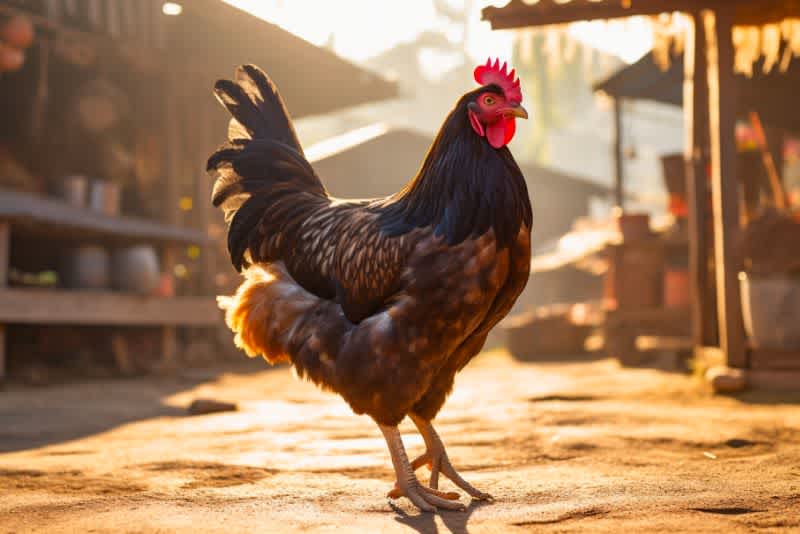
Have you ever wondered what makes Black Copper Marans the Picasso of the poultry world? Join us as we check out the mesmerizing world of these birds, famed for their luxurious, dark chocolate-colored eggs.
Envision the pride and joy of nurturing a breed that combines aesthetic elegance with prolific egg production.
Read on to uncover the requirements for successfully raising Black Copper Marans and how you can transform your poultry-keeping experience with these exquisite birds.
Detailed Overview of Black Copper Marans
History and Origin

Originating from a small town called Marans, in western France, Black Copper Marans have a unique lineage worth noting. They were created from a medley of chickens that happened to wander through this town. The story of their origin reveals a diverse genetic palette, which is reflected in their striking appearance and robust nature.
In the early 1900s, these birds made a name for themselves by producing dark chocolate-brown eggs, a feature that would soon make them highly sought after. They crossed the English Channel and soon spread across the pond, where flock keepers appreciated them as exceptional egg layers. Their journey from a small town in France to nesting boxes worldwide is a testament to their resilience and appeal.
Physical Characteristics
The physical presentation of the Black Copper Marans is as striking as its history. To begin, their plumage stands out. The combination of black and copper feathers creates a mesmerizing contrast. This distinctive appearance is complemented by an upright, confident stance that exudes bold confidence.
The males grow up to 8 lbs while females can reach up to 7 lbs, constituting a medium to large chicken breed. This size is apt for their sturdy, strong legs that are often feathered but can vary from one bird to another. They showcase a single, prominent red comb atop a black or slate-blue face, adding more vibrancy to their looks.
A long, broad back and a moderately full chest wrap up their body structure. However, remember that there may be variations, with some having a more prominent chest or a narrower back, adding to their uniqueness.
Personality and Temperament
While the Black Copper Marans's beauty is evident, their personality seals the deal for poultry enthusiasts. They are generally considered a calm breed with a laid-back temperament. They are also very intelligent, making them easy to handle, a trait much appreciated by those raising backyard chickens.
However, don't let their calm demeanor mislead you into thinking they are not active. They enjoy a good forage and are rather efficient at it. On the other hand, they are most likely to respect garden boundaries and not wreak havoc on your cherished plants.
Nonetheless, each bird is an individual, and personality traits may vary. It is important to understand that these gentle creatures demand respect and care. Paying attention to their needs and providing good living conditions will ensure you enjoy their company and they reciprocate with a steady supply of those coveted chocolate-colored eggs.
French Black Copper Marans vs Black Copper Marans
Two variants stand out when discussing copper marans: the French Black Copper Marans and the Black Copper Marans. At first glance, their luxurious black feathers with copper highlights seem identical, yet subtle differences set them apart.
The Feathered Difference: The French Black Copper Marans, true to its French roots, boasts feathered legs - a trait initially found in the original Marans breed. This feathering is less common in the Black Copper Marans, particularly in British-bred birds, reflecting a preference for clean-legged poultry in the UK.
Historical Pathways: The journey of these birds, originating from the Marans region of France, is a story of adaptation and evolution. The French Black Copper Marans hold a special place in poultry history, having been standardized by the American Poultry Association. This recognition has only increased their popularity.
Egg-cellent Differences: While both varieties lay the same coveted dark eggs, the French Black Copper Marans often produces the darkest eggs. These darker eggs are a signature of the breed and a hallmark of their quality.
A Matter of Maintenance: The feathered legs of the French Black Copper Marans, while visually striking, come with higher maintenance needs. These feathers can trap dirt and moisture, necessitating more regular cleaning to prevent issues like frostbite in colder climates.
Physical Prowess: Both varieties share a triangular body shape with wide, strong shoulders, but it's the shimmer of green iridescence on their jet-black feathers that truly catches the eye, especially under sunlight. The hens, slightly smaller than their rooster counterparts, embody the grace and strength of the breed.
Black Copper Marans Egg Production
With enticing dark chocolate eggs, Black Copper Marans attract poultry enthusiasts and backyard chicken keepers alike with their impressive egg-laying capacity. This section dives deeper into three fundamental facets of their egg production - rate, size and color, and the age at which they start to lay.
Understand the factors influencing their egg production rate.
Get a glimpse of their unique egg size and color.
Decipher the age when Black Copper Marans start to lay.
Egg Production Rate
Black Copper Marans, revered worldwide for their egg quality and quantity, lay approximately 150 to 200 eggs annually on average. Predominantly, the rate of egg production largely depends on factors such as breed, age, health, and diet. The Black Copper variety is notorious for being seasonal layers, frequently refraining from laying during the darker, colder winter months.
A direct correlation exists between the care provided and the egg output. Optimal dietary supplements, regular health checks, and a stress-free environment can drastically improve the egg-laying abilities of these breeds. They are known for their versatility and adjust well to free-range and confined poultry management systems.
Dark Egg Color and Size
The characteristic dark-chocolate hue of Black Copper Marans' eggs sets them apart, scoring as high as 4-7 on the Marans Egg Color Chart. The depth of color, however, may vary throughout the laying cycle, with eggs laid in the initial phase being darker.
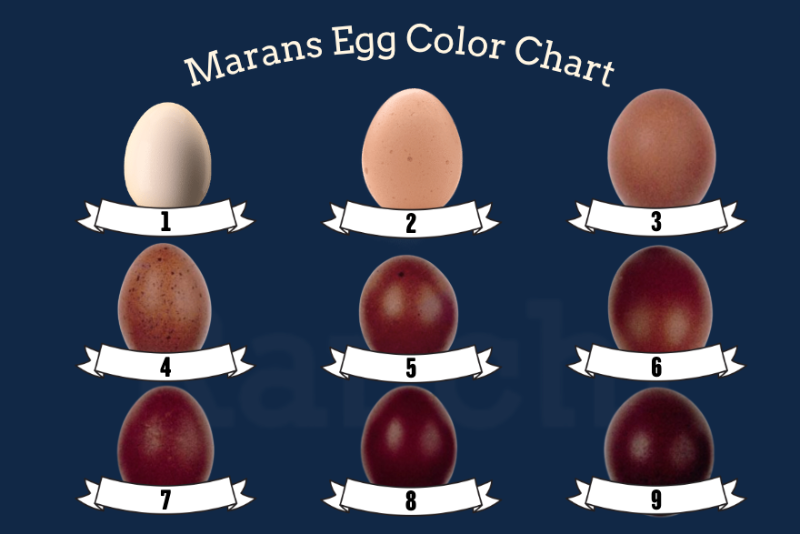
The egg size ranges from medium to large, with the older hens laying larger eggs compared to the younger ones. In addition, nutritional availability and the hen's health come into play regarding the size of the eggs. The provision of calcium-rich food significantly aids in producing good-sized eggs and safeguards the hens against potential health anomalies.
Egg Laying Age
From baby chicks to adults, the egg-laying prowess in Black Copper Marans is triggered around 5-6 months mark, although it may vary on individual health and growth rate. Starting as pullets, their egg-laying cycle can swiftly gear up to full swing within a few weeks more than other breeds. In addition, attention to their nutrition and care during the pullet stage can help encourage a healthy and robust laying cycle later on. Following the initial egg-laying spur, they may go through molt before reinitiating the next laying cycle. This is a natural phase in the hens' life to replenish energy and body condition.
Caring for Black Copper Marans
Adaptive housing and space ensure healthy growth.
Optimum feeding meets nutritional requirements.
Hygiene and vaccinations prevent disease outbreaks.
Housing and Space Requirements
Black Copper Marans are robust and sturdy, reputed for their excellent adaptability. While initially bred in a coastal French town, these chickens thrive in harsh climates, from chilly winters to humid summers. Housing concerns should prioritize warmth, ventilation, space, and protection.
Creating a Comfortable Coop

Every chicken needs a safe, comfy coop to call home. Generally, a Maran chicken requires around 2 square feet inside the coop and another 8 square feet outdoors. A bigger pen provides room for dust baths and natural foraging. Outfit their homes with roosting bars for them to perch on at night, and plenty of nests for the hens to lay eggs.
Outdoor Feeding Space
Having an outdoor area also provides an abundant source of natural food. The outdoor section should be fenced to keep predators out, with ample room for movement and exercise.
Feeding and Nutrition
Feeding the right nutrients ensures the health and productivity of the chickens. Although Black Copper Marans are hardy birds, they need a balanced diet for optimum growth and egg production.
Types of Feed
Typically, growers use chicken starter feed that includes proteins, carbohydrates, fats, minerals, and vitamins. As Marans are prodigious layers, feed should constitute 15-18% protein for optimal egg quality and consistency.
Supplementing Diet
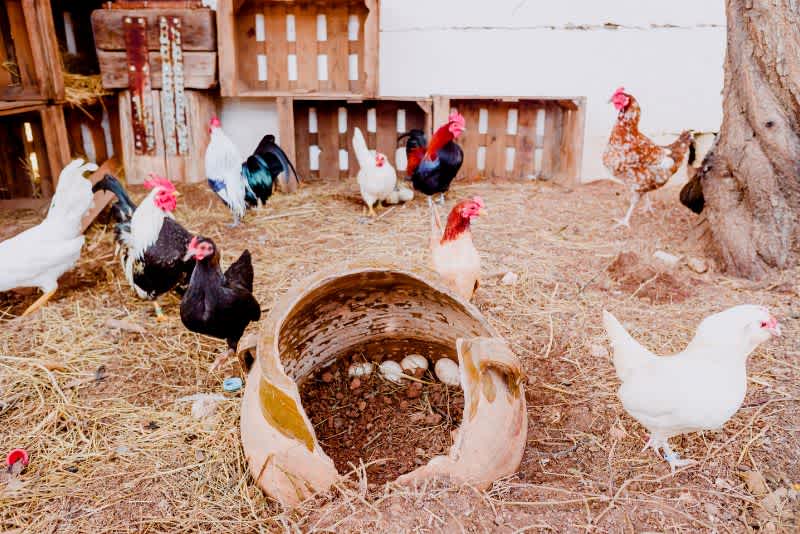
Free-ranging these birds supplements their diet tremendously, allowing them to consume a varied diet of greens, seeds, worms, and insects. Additionally, grit and oyster shell supplements enhance digestion and provide the necessary calcium to strengthen eggshells.
Health Issues and Care
While Marans are generally healthy, certain health issues can arise if not monitored.
Common Health Issues
Some regular health issues among the breed include parasitic infestations, respiratory diseases, and Egg Binding in hens. Regular check-ups and appropriate medication can mitigate these problems.
Hygiene and Vaccinations
Maintaining a clean environment is paramount in preventing a disease outbreak. Routine cleaning, adequate ventilation, and space prevent the buildup of harmful material. Vaccinations against common diseases such as Newcastle Disease and Avian Influenza are advisable to keep chickens healthy.
Breeding Black Copper Marans
Breeding Process
The Breeding process of Black Copper Marans, like any chicken breed, begins with selecting healthy, active, and fertile birds. The hen should have a bright and clear eye, a red comb, and a well-rounded body - signs of a healthy bird.
When it comes to the rooster, choose one that is robust and eager. Look at the feather quality, body size, and active behavior. A healthy rooster is necessary to ensure successful fertilization of the eggs.
Incubation of eggs plays a vital role in the breeding process. Regular candling of the eggs is necessary to check the chick's growth.
Caring for Baby Chicks
Once the eggs have hatched, the real challenge begins - caring for baby chicks. The hatched baby chicks require a warm and controlled environment, as these first few days are critical to their survival.
A brooder, essentially a heated home for chicks, is the first requirement. The brooder's temperature should remain between 93-95 degrees Fahrenheit for the first week, gradually decreasing by 5 degrees per week until the chicks are fully feathered.
Age | Brooding Temperature |
0 to 1 week | 93° to 95°F (33.9° to 35°C) |
1 to 2 weeks | 88° to 90°F (31.1° to 32.2°C) |
2 to 3 weeks | 83° to 85°F (28.3° to 29.4°C) |
3 to 4 weeks | 78° to 80°F (25.6° to 26.7°C) |
4 to 5 weeks | 75°F (23.9°C) |
5 to 6 weeks | 70°F (21.1°C) |
6 weeks and over | Comfort Zone 50° to 70°F (10° to 21.1°C) |
Source: table data from colostate.edu
Proper feeding is crucial for their growth. A balanced diet rich in protein is necessary to develop the baby chicks properly. Provide them with a starter feed enhanced with essential vitamins and minerals.
Hygiene plays a significant role in chick care. Cleaning the brooder regularly and ensuring it remains dry goes a long way towards preventing diseases. Vaccinations also play a part in providing immunity against common poultry illnesses – so include this in your chick care routine.
This well-rounded approach to breeding and chick care should help you enjoy a successful Black Copper Marans rearing experience.
Buying Black Copper Marans
If you're looking to expand your poultry selection, Black Copper Marans are a reliable choice to consider.
Where to Buy
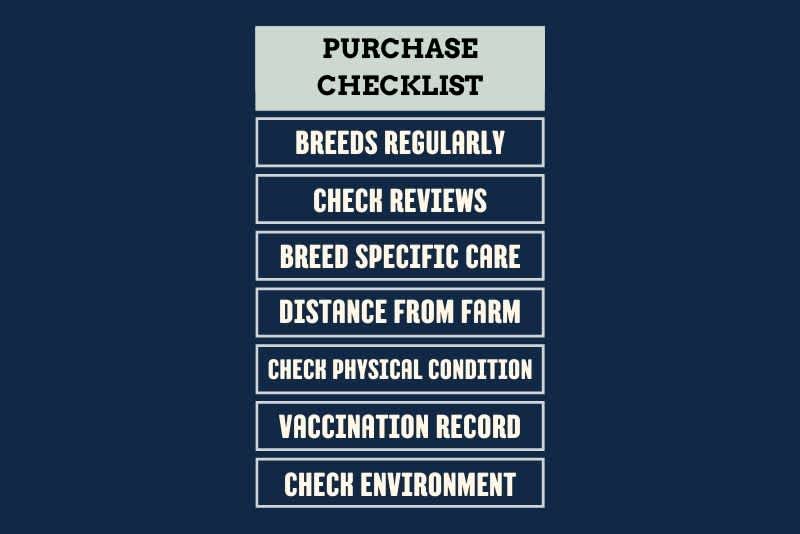
When considering the purchase of Black Copper Marans, the sale source plays a critical role in the quality of your new birds. It's recommended to opt for reputable poultry farms or hatcheries that are known for their dedication towards ethical breeding practices and maintaining the breed's purity.
Some large-scale online marketplaces also offer Black Copper Marans, though the quality assurance may not be as high as a dedicated breeder. It's crucial to do your due diligence in researching the seller's reputation, customer reviews, and overall knowledge about the breed.
In selecting a seller or breeder, always consider their proximity to your location. Choosing a nearby breeder allows for interaction with the birds before purchase and lessens the stress on the bird due to travel.
Here's a quick checklist for finding a reliable source:
Does the seller breed Black Copper Marans regularly?
What kind of reviews and ratings have they received?
Are they knowledgeable about the breed's specific care requirements?
How far will the birds need to travel?
Price Range
As with any investment, understanding the potential price range sets realistic expectations when planning to acquire Black Copper Marans. Generally, the cost varies based on a few factors - age, production quality, bloodlines, and whether the bird is sexed or unsexed.
While day-old chicks can be purchased for as low as $4 to $6, high-quality show birds can range up to $15+ each. If you're considering these birds from a premium bloodline, the price may even exceed a couple of hundred dollars. It's important to note that prices fluctuate and differ between sellers.
On average, you should budget around $10 to $30 per chicken, bearing in mind the additional cost for feeding, housing and other necessary care expenses too. Always remember, paying for quality is a worthy investment in the long run, and helps to ensure a healthy, productive flock.
Points to remember when considering price:
Age and sex of the bird influence the price
High-quality breed strains fetch a higher price
Consider the additional costs of care and maintenance
Prices can fluctuate depending on the market and breeder reputation
Remember, the rewards of Black Copper Marans - including their richly-hued eggs, docile nature and visually appealing feather patterns - immediately validate investing in this breed. Be sure to account for these factors as you deliberate on your poultry investment plans.
Pros and Cons of Raising Black Copper Marans
Don't let the allure of Black Copper Marans' impressive egg color distract you from the realities of raising this particular breed. Let's examine the ups and downs that come with Black Copper Marans egg farming.
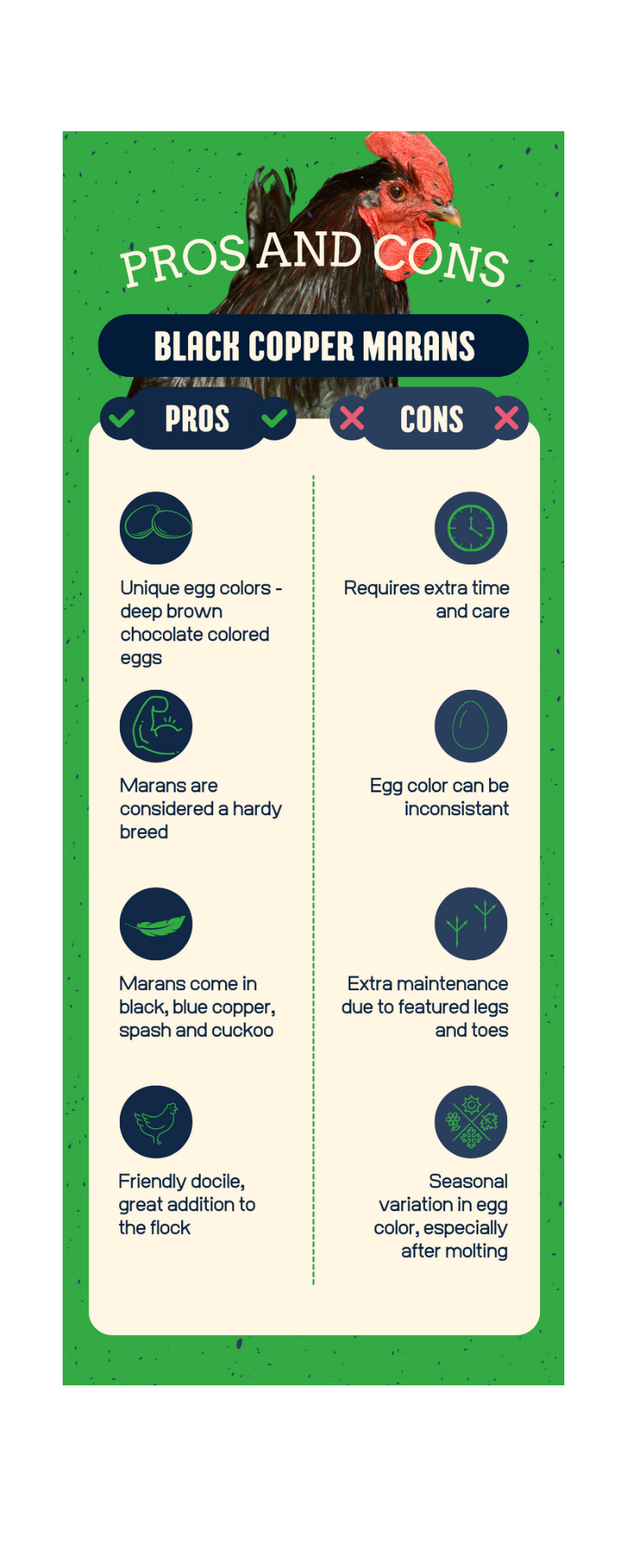
Advantages of the Black Copper Marans chicken
Marans are a resilient breed, noted for their robustness and adaptability. Known as one of the hardiest chicken breeds to elevate, they can tolerate varying weather conditions. When it comes to managing their nutrition, Black Copper Marans tend to be less picky than other breeds.
Their robustness is complemented by their adaptability. A major component of raising livestock is recognizing the different personality traits breeds can have. With the Black Copper Marans chicken, you get a breed that finds ease in adjusting to new living situations, making them a great addition if you're looking to diversify your flock. They are relatively social and get along well in mixed flocks.
Lastly, let's not forget about the egg. Black Copper Marans lay a unique medium brown to dark brown egg size. The darkness of the eggshell is striking and appeals to many poultry enthusiasts and egg collectors. This egg color is rare, which causes a high demand and makes the rewards for raising Black Copper Marans high.
Disadvantages of Black Copper Marans
While the benefits of raising Black Copper Marans are numerous, some considerations may impact your decision on whether or not to introduce this breed to your farm.
The incubation process for Marans, specifically Black Copper Marans, is notoriously finicky. Eggs from these hens have a thicker shell and membrane, making it difficult for chicks to hatch. Raising this breed from chicks demands a significant amount of time and care.
Moreover, although the rare, dark brown eggs laid by Black Copper Marans can fetch a higher price, they can also be irregular. Egg color inconsistencies might happen and eggs can vary in darkness throughout the laying cycle of a hen. This irregularity may pose a problem if consistency is important to your buyers.
This breed also possesses a gene that can cause feathered legs and toes, which could be viewed as a disadvantage if you’re seeking a specific aesthetic for your flock.
Sure, Black Copper Marans demand a good deal of attention and care. Still, they are also a hardy, personable, and unique addition to any flock, with the added bonus of laying beautiful, dark eggs which may well be worth your effort. A careful read of the situation could very much clarify if raising Black Copper Marans is the right fit for you.
Real-Life Experiences with Black Copper Marans
Honest accounts from active raisers
Lessons learned from failures and successes
Informed practical tips for care and maintenance
Hearing from the Experts
Nothing tests theories and advice more effectively than real, hands-on experiences. Raisers of Black Copper Marans have a wealth of invaluable insights to offer. With a range of experiences that are as diverse as their flock, these farmers open up about their day-to-day interactions with the breed.
One common observation mentioned is how the breed's docile nature makes handling easier. Having these birds in their backyard proved to be less stressful than more skittish chicken varieties.
However, should one fail to enforce adequate predator protection, you may have some disaster stories on hand. The Black Copper Marans' calm nature can, unfortunately, make them easy targets. Thus, proper predator-proofing procedures can't be overlooked or underestimated.
The owners at Mr Animal Farm, Kristin and Justin say:
"They lay quite well through the winter... which is awesome."
Learning from Past Mistakes
Learning about potential pitfalls in raising Black Copper Marans can save you from replicating prior mistakes. Anecdotal evidence underscores the importance of practicing diligent care and vigilant maintenance.
One farmer stressed the need to monitor the flock's diet. Black Copper Marans may not produce as many eggs on a protein-heavy feed. They thrive best on a carefully balanced diet.
Moreover, be mindful of flock dynamics. Introducing new birds can disrupt established social order, potentially leading to disputes and stress for the birds. So, ensuring a smooth integration is vital for their well-being.
Practical Care Tips
Off the record, these Black Copper Marans raisers have passed down nuggets of wisdom for the ambitious beginner.
Firstly, hygiene – clean coops can't be emphasized enough. Regular cleaning activities provide for a healthy environment, reducing the chances of potential sicknesses.
Subsequently, implement scheduled feeding rather than leaving feed out all day. This method encourages natural foraging behavior and helps manage the flock's weight.
Lastly, raising these birds needs a long-term commitment. Patience is key as Black Copper Marans are not fast growers. They might even test your patience regarding egg-laying. But, these unique dark brown egg layers can be truly rewarding in your coop; many would say they are even worth the wait.
Armed with these experiences, you are now better equipped to tackle the challenges of raising your own group of Black Copper Marans. Remember, persistence, patience, and preparedness always pay off.
Let's Get Raising
The Black Copper Marans breed represents a unique combination of aesthetic appeal, egg color, and durability—special attention to diet and exercise aids in producing their beautiful chocolate brown colored eggs.
As we’ve seen, understanding the breed details and putting the proper care measures in place goes a long way. Now, it's time to implement what you've learned. Go on, transform your coop with a flock of Black Copper Marans, and watch as the shells of regular eggs pale in comparison.
But before you embark on this journey, ask yourself: are you ready to dedicate your time and effort to bring out the best in these feathered picassos?
Keep track of all your cattle with the #1 Cattle Management Software
Try out Ranchr today for free